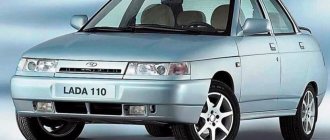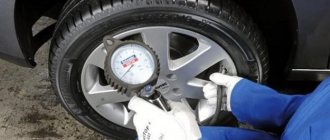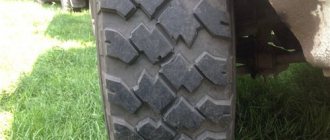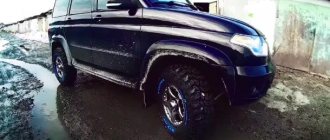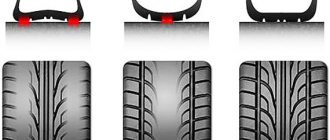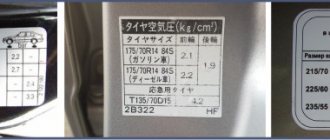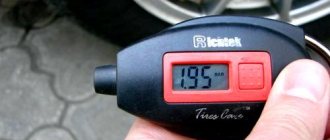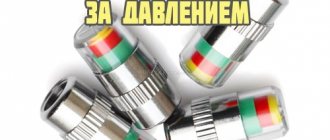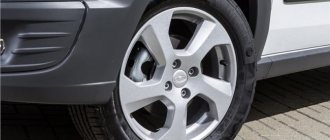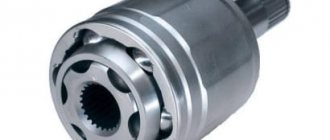The domestic auto industry rarely spoils us with new vehicles, so there is not much variety of Russian cars on the roads. However, many car enthusiasts who own cars such as the VAZ 2107 or 2114 or 2115 do not want to part with them and drive them around the expanses of Russia for many years. No one can explain why Lada is so popular in our time - this is the second name for these cars. Everyone has their own reasons for not parting with their “old friend.”
VAZ tire
Since many VAZ car models have not rolled off the assembly line for a long time, one cannot expect that they will be equipped with the latest functions. Naturally, their safety is a complete disaster; apart from a seat belt, there is no protection. Experienced drivers increase the safety of their lives by always monitoring the tire pressure of their VAZ car. In addition, this allows us to reduce wear and tear on vehicles, which is important.
WHAT IS THE RISK OF DEVIATION FROM THE SET PARAMETERS
Front-wheel drive cars of the Volzhsky Automobile Plant, such as the VAZ 2110, VAZ 2114 and VAZ 2115, can be equipped with wheels with a radius of R13, R14, R15 and R16, but the standard cars are equipped only with rims and tires of the 13th and 14th radius. The optimal tire pressure depends primarily on the load and weight of the vehicle; much also depends on road conditions and ambient temperature.
If the wheels are poorly inflated, then:
- The tire tread will wear out faster;
- It will become more difficult to control the car and turn the steering wheel harder;
- Fuel consumption will increase, and the more flat the tires, the more noticeable the gasoline consumption;
- The car will become prone to skidding, especially on wet and snowy roads, and stability will be lost;
- The power of the car will decrease as the resistance to movement will increase.
If the wheels are inflated more than normal, then this is also not very good:
- When driving, you can feel all the unevenness of the road surface and the ride becomes uncomfortable. In addition, the chassis wears out faster;
- Due to less grip on the road surface, the braking distance is longer, which has a detrimental effect on traffic safety;
- The tire tread wears unevenly, and the service life of the tires is noticeably reduced;
- A hernia may appear on the wheel, and under high pressure when hitting an obstacle, the rubber may rupture, which is completely unsafe at high speed.
Below are three pictures that show how the rubber tread adheres to the road at optimal, low and excess pressure.
Many car owners are wondering what pressure should be in R14 tires on VAZ models. According to technical conditions, the wheels on a VAZ 2114 (2115) car are inflated to 1.9 kgf/cm² (R13), on VAZ 2110-2112 cars it is recommended 2.0 kgf/cm² (R14). Moreover, it makes no difference what axle the wheels are on - front or rear.
Review of the best summer and winter tires
It is better to acquire separate sets of summer and winter tires in advance. Pirelli Cinturato P1 Verde tires are ideal for the warm season. Their cost is relatively high (from 3,500 rubles per 1 tire). However, they perform excellently on wet asphalt and are highly resistant to wear.
- Continental Conti Premium Contact 5 is well balanced. There are a large number of special drainage channels - they make it easy to drain water from the contact patch. This kit will cost slightly less than the one discussed above.
- Goodyear EfficientGrip Performance provides good grip and low fuel consumption. However, the tread thins out quite quickly - especially during intense driving. The rubber is soft and handles well. Despite its softness, it is difficult to damage it redder.
- Dunlop Sport BluResponse is relatively cheap compared to all the options discussed above. However, it has its weaknesses. For example, on wet asphalt the wheels slip a lot and handling deteriorates.
- Semperit Comfort-Life 2 is a rare guest on Russian territory. However, on dry asphalt at positive temperatures it performs more than well. However, rubber is distinguished by its noise.
- GOODYEAR 175/70R14 UG ICE ARCTIC D-STUD - studded tires at a relatively low cost. Regardless of the ambient temperature, it retains its flexibility and softness. Cost – from 4,000 rubles.
- HANKOOK 175/70R14 W429 is a more budget option. Cost – from 2,800 rubles. Thanks to the deep tread and flexible design, the driver can feel completely safe on the road.
- KUMHO 175/70R14 WI31 84T usually costs several hundred rubles cheaper than the modification discussed above. The presence of studs makes this tire safe on almost any road.
- VIATTI TIRES 175/70R14 BRINA NORDICO is manufactured using rubber mixing technology. Reinforced lugs make this model indispensable not only in winter, but also on dirt roads in summer.
- SAVA 175/70R14 ESKIMO ICE MS is the most profitable option. It has a relatively low price (from 2,000 rubles). There are no thorns. However, the deep tread and its shape provide high-quality, reliable contact with any surface.
Choosing suitable tires for the VAZ 2110 is a relatively simple process. However, it is important to familiarize yourself with the intricacies of tire selection in advance. Wheels that are too large can easily damage the vehicle body.
Tired of paying fines? There is an exit!
Forget about fines from cameras! An absolutely legal new product - Traffic Police Camera Jammer, hides your license plates from the cameras that are installed in all cities.
More details at the link.
- Absolutely legal (Article 12.2);
- Hides from photo and video recording;
- Suitable for all cars;
- Works through the cigarette lighter connector;
- Does not cause interference to radios and cell phones.
INFLUENCE OF WEATHER CONDITIONS AND ROAD FACTORS
The pressure in VAZ tires in summer should, in principle, be the same as in winter. But in practice in winter it is made a little lower for a number of reasons:
- Slightly lower tires allow you to better control the car on slippery roads, it becomes more stable;
- The suspension is made softer, and road unevenness is less felt;
- The braking distance becomes shorter, reducing the likelihood of an emergency.
It is necessary to take into account the fact that after a temperature change (after leaving a warm garage on a frosty street), the pressure in the R14 tires will become less due to physical factors. Therefore, you should check it before you hit the road and, if necessary, pump up the tires. Also, when it gets warmer after winter, pressure measurements should be taken.
The pressure in R13 tires in summer is usually maintained at 1.9 atm, but this level is designed for an average vehicle load (two or three people in the cabin). If the car is fully loaded, then the pressure should be increased on the front axle to 2.0-2.1 atm., on the rear axle to 2.3-2.4 atm. The spare wheel is inflated to 2.3 atm.
Russian roads are not of good quality, and therefore many car owners deliberately lower the tire pressure somewhat so that all the unevenness of the road surface is not so noticeably felt when driving. Typically, in summer the wheels are lowered by 5-10%, and in winter by 10-15% of the norm. On flat roads you can stick to the factory standard.
For example, a table of car tire pressures:
For example, a table of car tire pressures
Table of permissible tire pressures for VAZ (Lada) passenger cars
| Model | Modifications | Recommended tire size | Recommended tire pressure | |||||||
| No load in summer | With load in summer | No load in winter | With load in winter | |||||||
| Front | Rear | Front | Rear | Front | Rear | Front | Rear | |||
| 2101 | 2101 1.2 (58 hp) | 155 SR13 | 1.6 | 1.6 | 1.6 | 1.7 | 1.5 | 1.5 | 1.5 | 1.6 |
| 2101 | 21011 1.3 (70 hp) | 165/70 SR13 | 1.6 | 1.6 | 1.6 | 1.7 | 1.5 | 1.5 | 1.5 | 1.6 |
| 2101 | 21013 1.2 (64 hp) | 155 SR13 | 1.6 | 1.6 | 1.6 | 1.7 | 1.5 | 1.5 | 1.5 | 1.6 |
| 2102 | 2102 1.2 (58 hp) | 155 SR13 | 1.6 | 1.6 | 1.6 | 1.7 | 1.5 | 1.5 | 1.5 | 1.6 |
| 2102 | 21021 1.3 (64 hp) | 155 SR13 | 1.6 | 1.6 | 1.6 | 1.7 | 1.5 | 1.5 | 1.5 | 1.6 |
| 2103 | 2103 1.5 (72 hp) | 175/70 SR13 | 1.9 | 1.9 | 1.9 | 1.9 | 1.8 | 1.8 | 1.8 | 1.8 |
| 2103 | 21033 1.3 (64 hp) | 175/70 SR13 | 1.9 | 1.9 | 1.9 | 1.9 | 1.8 | 1.8 | 1.8 | 1.8 |
| 2104 | 2104 1.3 (64 hp) | 175/70 SR13 | 1.6 | 2.2 | 1.6 | 2.3 | 1.5 | 2.1 | 1.5 | 2.2 |
| 2104 | 21043 1.5 (70 hp) | 165/70 R13 | 1.6 | 2.1 | 1.6 | 2.2 | 1.5 | 2 | 1.5 | 2.1 |
| 2104 | 21045 1.5 D (50 hp) | 175/65 R13 | 1.6 | 2.2 | 1.6 | 2.3 | 1.5 | 2.1 | 1.5 | 2.2 |
| 2104 | 21047 1.7 i (79 hp) | 165 SR 13 | 1.6 | 2.1 | 1.6 | 2.2 | 1.5 | 2 | 1.5 | 2.1 |
| 2104 | 21048 1.8 D (64 hp) | 175/60 R13 | 1.6 | 2.2 | 1.6 | 2.3 | 1.5 | 2.1 | 1.5 | 2.2 |
| 2105 | 2105 1.3 (64 hp) | 175/70 SR13 | 1.9 | 1.9 | 1.9 | 2 | 1.8 | 1.8 | 1.8 | 1.9 |
| 2105 | 21051 1.2 (59 hp) | 175/50 R13 | 1.9 | 1.9 | 1.9 | 2 | 1.8 | 1.8 | 1.8 | 1.9 |
| 2105 | 21053 1.5 (68 hp) | 165/65 R13 | 2 | 2 | 2 | 2 | 1.9 | 1.9 | 1.9 | 1.9 |
| 2106 | 2106 1.6 (75 hp) | 175/50 R16 | 2 | 2 | 2 | 2 | 1.9 | 1.9 | 1.9 | 1.9 |
| 2106 | 21061 1.5 (71 hp) | 175/50 R13 | 2 | 2 | 2 | 2 | 1.9 | 1.9 | 1.9 | 1.9 |
| 2106 | 21063 1.3 (64 hp) | 175/70 R13 | 1.9 | 1.9 | 1.9 | 1.9 | 1.8 | 1.8 | 1.8 | 1.8 |
| 2106 | 21065 1.5 (71 hp) | 175/50 R13 | 2 | 2 | 2 | 2 | 1.9 | 1.9 | 1.9 | 1.9 |
| 2106 | 1.5 i (56 kW) | 165/70 R 13 79 T | 2 | 2 | 2 | 2 | 1.9 | 1.9 | 1.9 | 1.9 |
| 2106 | 1.5 i (56 kW) | 175/70 R 13 82 T | 1.9 | 1.9 | 1.9 | 1.9 | 1.8 | 1.8 | 1.8 | 1.8 |
| 2106 | 1.5 i (56 kW) | 185/60 R 14 82 T | 1.9 | 1.9 | 1.9 | 1.9 | 1.8 | 1.8 | 1.8 | 1.8 |
| 2107 | 2107 1.5 (71 hp) | 175/70 SR13 | 1.9 | 1.9 | 2 | 2 | 1.8 | 1.8 | 1.9 | 1.9 |
| 2107 | 21072 1.3 (64 hp) | 175/50 R13 | 2 | 2 | 2 | 2 | 1.9 | 1.9 | 1.9 | 1.9 |
| 2107 | 21073 1.7 (76 hp) | 165/55 R14 | 1.9 | 1.9 | 2 | 2 | 1.8 | 1.8 | 1.9 | 1.9 |
| 2107 | 21074 1.6 (74 hp) | 165/65 R13 | 2 | 2 | 2 | 2 | 1.9 | 1.9 | 1.9 | 1.9 |
| 2107 | 1.5 i (56 kW) | 165/70 R 13 79 T | 2 | 2 | 2 | 2 | 1.9 | 1.9 | 1.9 | 1.9 |
| 2107 | 1.5 i (56 kW) | 175/70 R 13 82 T | 1.9 | 1.9 | 1.9 | 1.9 | 1.8 | 1.8 | 1.8 | 1.8 |
| 2107 | 1.5 i (56 kW) | 185/60 R 14 82 T | 1.9 | 1.9 | 1.9 | 1.9 | 1.8 | 1.8 | 1.8 | 1.8 |
| 2108 | 2108 1.3 (64 hp) | 165/70 SR13 | 2 | 2 | 2 | 2 | 1.9 | 1.9 | 1.9 | 1.9 |
| 2108 | 21081 1.1 (54 hp) | 165/70 R13 S | 2 | 2 | 2 | 2 | 1.9 | 1.9 | 1.9 | 1.9 |
| 2108 | 21083 1.5 (80 hp) | 175/60 R13 | 2 | 2 | 2 | 2 | 1.9 | 1.9 | 1.9 | 1.9 |
| 2108 | 1.5 i (56 kW) | 165/70 R 13 79 T | 2 | 2 | 2 | 2 | 1.9 | 1.9 | 1.9 | 1.9 |
| 2108 | 1.5 i (56 kW) | 175/70 R 13 82 T | 1.9 | 1.9 | 1.9 | 1.9 | 1.8 | 1.8 | 1.8 | 1.8 |
| 2108 | 1.5 i (56 kW) | 185/60 R 14 82 T | 1.9 | 1.9 | 1.9 | 1.9 | 1.8 | 1.8 | 1.8 | 1.8 |
| 2109 | 2109 1.3 (64 hp) | 165/70 SR13 | 2 | 2 | 2 | 2 | 1.9 | 1.9 | 1.9 | 1.9 |
| 2109 | 21091 1.1 (54 hp) | 165/55 R14 | 2 | 2 | 2 | 2 | 1.9 | 1.9 | 1.9 | 1.9 |
| 2109 | 21093 1.5 (76 hp) | 165/55 R14 | 1.9 | 1.9 | 1.9 | 1.9 | 1.8 | 1.8 | 1.8 | 1.8 |
| 2109 | 1.5 i (56 kW) | 165/70 R 13 79 T | 2 | 2 | 2 | 2 | 1.9 | 1.9 | 1.9 | 1.9 |
| 2109 | 1.5 i (56 kW) | 175/70 R 13 82 T | 1.9 | 1.9 | 1.9 | 1.9 | 1.8 | 1.8 | 1.8 | 1.8 |
| 2109 | 1.5 i (56 kW) | 185/60 R 14 82 T | 1.9 | 1.9 | 1.9 | 1.9 | 1.8 | 1.8 | 1.8 | 1.8 |
| 21099 | 21099 1.5 (70 hp) | 175/50 R13 | 1.9 | 1.9 | 1.9 | 1.9 | 1.8 | 1.8 | 1.8 | 1.8 |
| 21099 | 21099 1.5i (76 hp) | 175/60 R13 | 1.9 | 1.9 | 1.9 | 1.9 | 1.8 | 1.8 | 1.8 | 1.8 |
| 21099 | 210993 1.3 (64 hp) | 175/50 R13 | 1.9 | 1.9 | 1.9 | 1.9 | 1.8 | 1.8 | 1.8 | 1.8 |
| 21099 | 210994 1.6i (80 hp) | 175/60 R13 | 1.9 | 1.9 | 1.9 | 1.9 | 1.8 | 1.8 | 1.8 | 1.8 |
| 2110 | 21100 1.5 (69 hp) | 175/70 SR13 | 1.9 | 1.9 | 1.9 | 1.9 | 1.8 | 1.8 | 1.8 | 1.8 |
| 2110 | 21101 1.6i (80 hp) | 175/50 R13 | 2 | 2 | 2 | 2 | 1.9 | 1.9 | 1.9 | 1.9 |
| 2110 | 21102 1.5 8v (79 hp) | 175/50 R13 | 2 | 2 | 2 | 2 | 1.9 | 1.9 | 1.9 | 1.9 |
| 2110 | 21103 1.5 16v (94 hp) | 175/50 R14 | 2 | 2 | 2 | 2 | 1.9 | 1.9 | 1.9 | 1.9 |
| 2110 | 21104 1.6 16v (89 hp) | 175/65 R14 | 2 | 2 | 2 | 2 | 1.9 | 1.9 | 1.9 | 1.9 |
| 2110 | 21106 2.0 16v GTI (148 hp) | 195 65/R15 | 2.2 | 2.2 | 2.2 | 2.2 | 2.1 | 2.1 | 2.1 | 2.1 |
| 2111 | 2111 1.5 8v (79 hp) | 175/65 R14 | 1.9 | 1.9 | 1.9 | 1.9 | 1.8 | 1.8 | 1.8 | 1.8 |
| 2111 | 21111 1.5 (72 hp) | 175/70 R13 | 1.9 | 1.9 | 1.9 | 1.9 | 1.8 | 1.8 | 1.8 | 1.8 |
| 2111 | 21112 1.6 8v (80 hp) | 175/50 R13 | 1.9 | 1.9 | 1.9 | 1.9 | 1.8 | 1.8 | 1.8 | 1.8 |
| 2111 | 21113 1.5 16v (89 hp) | 175/60 R14 | 1.9 | 1.9 | 1.9 | 1.9 | 1.8 | 1.8 | 1.8 | 1.8 |
| 2111 | 21114 1.6 16v (90 hp) | 175/60 R14 | 2 | 2 | 2 | 2 | 1.9 | 1.9 | 1.9 | 1.9 |
| 2111 | 2111-90 (Tarzan) 1.8 (85 hp) | 205/70 R15 | 2.4 | 2.4 | 2.4 | 2.4 | 2.3 | 2.3 | 2.3 | 2.3 |
| 2112 | 2112 1.5 16v (94 hp) | 175/65 R14 | 1.9 | 1.9 | 1.9 | 1.9 | 1.8 | 1.8 | 1.8 | 1.8 |
| 2112 | 21121 1.6 (75 hp) | 175/55 R15 | 1.9 | 1.9 | 1.9 | 1.9 | 1.8 | 1.8 | 1.8 | 1.8 |
| 2112 | 21122 1.5 (76 hp) | 175/60 R14 | 2 | 2 | 2 | 2 | 1.9 | 1.9 | 1.9 | 1.9 |
| 2113 | 2113 1.5 (79 hp) | 165/70 R13 | 1.9 | 1.9 | 1.9 | 1.9 | 1.8 | 1.8 | 1.8 | 1.8 |
| 2113 | 21134 1.6 (81 hp) | 175/50 R13 | 2 | 2 | 2 | 2 | 1.9 | 1.9 | 1.9 | 1.9 |
| 2114 | 2114 1.5 (77 hp) | 165/70 R13 | 1.9 | 1.9 | 1.9 | 1.9 | 1.8 | 1.8 | 1.8 | 1.8 |
| 2114 | 21144 1.6 (81 hp) | 175/50 R13 | 2 | 2 | 2 | 2 | 1.9 | 1.9 | 1.9 | 1.9 |
| 2115 | 2115 1 | 5 (76 hp) | 175/70 R13 | 2 | 2 | 2 | 2 | 1.9 | 1.9 | 1.9 |
| 2115 | 2115-4 1.6 (80 hp) | 175/60 R14 | 2 | 2 | 2 | 2 | 1.9 | 1.9 | 1.9 | 1.9 |
| 2120 | 2120 1.7i (84 hp) | 175/80 R16 | 2.1 | 2.1 | 2.1 | 2.1 | 2 | 2 | 2 | 2 |
| 2120 | 21214 1.7 i (80 hp) | 175/80 R16 | 2.1 | 2.1 | 2.1 | 2.1 | 2 | 2 | 2 | 2 |
| 2131 | 2131 1.7 (76 hp) | 175/80 R16 | 2.1 | 2.1 | 2.1 | 2.1 | 2 | 2 | 2 | 2 |
| 2131 | 2131-02 1.8 (82 hp) | 175/80 R16 | 2.1 | 2.1 | 2.1 | 2.1 | 2 | 2 | 2 | 2 |
| Priora | 1.6 (72 kW) | 175/65 R 14 82 H | 2 | 2 | 2 | 2 | 1.9 | 1.9 | 1.9 | 1.9 |
| Priora | 1.6 (72 kW) | 185/65 R 14 86 H | 2 | 2 | 2 | 2 | 1.9 | 1.9 | 1.9 | 1.9 |
| Priora | 1.6 | 175/70 R13 | 1.9 | 1.9 | 2 | 2 | 1.8 | 1.8 | 1.9 | 1.9 |
| Priora | 1.6 | 175/65 R14 | 2 | 2 | 2.1 | 2.1 | 1.9 | 1.9 | 2 | 2 |
| Priora | 1.6 | 185/60 R14 | 2 | 2 | 2.1 | 2.1 | 1.9 | 1.9 | 2 | 2 |
| Priora | 1.6 | 185/55 R15 | 2.1 | 2.2 | 2.2 | 2.2 | 2 | 2.1 | 2.1 | 2.1 |
| Priora | 1.6 | 190/50 R15 | 2.3 | 2.4 | 2.4 | 2.4 | 2.2 | 2.3 | 2.3 | 2.3 |
| Granta | 1.6 | 175/70 R13 | 1.9 | 1.9 | 2 | 2 | 1.8 | 1.8 | 1.9 | 1.9 |
| Granta | 1.6 | 175/65 R14 | 2 | 2 | 2.1 | 2.1 | 1.9 | 1.9 | 2 | 2 |
| Granta | 1.6 | 185/60 R14 | 2 | 2 | 2.1 | 2.1 | 1.9 | 1.9 | 2 | 2 |
| Granta | 1.6 | 185/55 R15 | 2.1 | 2.2 | 2.2 | 2.2 | 2 | 2.1 | 2.1 | 2.1 |
| Granta | 1.6 | 190/50 R15 | 2.3 | 2.4 | 2.4 | 2.4 | 2.2 | 2.3 | 2.3 | 2.3 |
| Largus (Largus) | 1.6 8V (64 kW) | 185/65 R 15 92 H | 2.4 | 2.6 | 2.4 | 2.6 | 2.3 | 2.5 | 2.3 | 2.5 |
| Largus (Largus) | 1.6 16V (77 kW) | 185/65 R 15 92 H | 2.4 | 2.6 | 2.4 | 2.6 | 2.3 | 2.5 | 2.3 | 2.5 |
| Niva (Niva) (21214 - 4×4) 93g- / 02g- / 10g- | 1.7 i (60 kW) | 205/70 R 15 96 T 4x4 | 1.8 | 1.9 | 1.8 | 1.9 | 1.7 | 1.8 | 1.7 | 1.8 |
| Niva (Niva (21214 - 4×4) 93g- / 02g- / 10g- | 1.7 (61 kW) | 215/65 R 16 98 Q 4x4 | 2.1 | 1.9 | 2.1 | 2.1 | 2 | 1.8 | 2 | 2 |
| 1111 (Oka) | 0 | 75 (35 hp) | 135/80 R12 | 2 | 2 | 2 | 2 | 1.9 | 1.9 | 1.9 |
| 1111 (Oka) | 0.65 (31 hp) | 135/80 R12 | 2 | 2 | 2 | 2 | 1.9 | 1.9 | 1.9 | 1.9 |
| Kalina (Kalina) (1117 - 1118 - 1119) 05g- | 1.6 (60 kW) | 175/65 R 14 82 T | 2 | 2 | 2 | 2.2 | 1.9 | 1.9 | 1.9 | 2.1 |
| Kalina (Kalina) (1117 - 1118 - 1119) 05g- | 1.6 (60 kW) | 185/60 R 14 82 T | 2 | 2 | 2 | 2.2 | 1.9 | 1.9 | 1.9 | 2.1 |
| Kalina (Kalina) (1117 - 1118 - 1119) 05g- | 1.4 16 V (66 kW) | 175/65 R 14 82 T | 2 | 2 | 2 | 2.2 | 1.9 | 1.9 | 1.9 | 2.1 |
| Kalina (Kalina) (1117 - 1118 - 1119) 05g- | 1.4 16 V (66 kW) | 185/60 R 14 82 T | 2 | 2 | 2 | 2.2 | 1.9 | 1.9 | 1.9 | 2.1 |
| Vesta (Vesta) | 1.6 MT (106 hp) | 185/65r15 88h | 2.1 | 2.1 | 2.2 | 2.2 | 2 | 2 | 2.1 | 2.1 |
| Vesta (Vesta) | 1.6 MT (106 hp) | 195/55r16 91h | 2.1 | 2.1 | 2.2 | 2.2 | 2 | 2 | 2.1 | 2.1 |
| Vesta (Vesta) | 1.6 AMT (106 hp) | 185/65r15 88h | 2.1 | 2.1 | 2.2 | 2.2 | 2 | 2 | 2.1 | 2.1 |
| Vesta (Vesta) | 1.6 AMT (106 hp) | 195/55r16 91h | 2.1 | 2.1 | 2.2 | 2.2 | 2 | 2 | 2.1 | 2.1 |
| Vesta (Vesta) | 1.8 MT (122 hp) | 185/65r15 88h | 2.1 | 2.1 | 2.2 | 2.2 | 2 | 2 | 2.1 | 2.1 |
| Vesta (Vesta) | 1.8 MT (122 hp) | 195/55r16 91h | 2.1 | 2.1 | 2.2 | 2.2 | 2 | 2 | 2.1 | 2.1 |
| Vesta (Vesta) | 1.8 AMT (122 hp) | 185/65r15 88h | 2.1 | 2.1 | 2.2 | 2.2 | 2 | 2 | 2.1 | 2.1 |
| Vesta (Vesta) | 1.8 AMT (122 hp) | 195/55r16 91h | 2.1 | 2.1 | 2.2 | 2.2 | 2 | 2 | 2.1 | 2.1 |
Didn’t find what you were looking for, then the search is for you:
Cars
Useful articles Useful life hacks
LARGER DIAMETER WHEELS
From the factory, the installation of wheels with diameters R15 and R16 is not provided, but some car enthusiasts, in pursuit of fashion and improved technical characteristics, install them on their VAZs. And accordingly, you need to know what the pressure should be in the R15 tires, and what the pressure should be in the R16 tires. It all depends on the workload of the VAZ model. With an average vehicle load, the wheels are inflated to 2 kgf/cm²; on a loaded car, it is better to inflate them to 2.2 kgf/cm². And if there is a lot of heavy luggage in the trunk, then the rear tires are pumped up by another 0.2 kgf/cm². It turns out that the pressure in R14 tires is approximately the same as the pressure in R15 and R16 tires (for VAZ 2110-2115 models).
What tire sizes does the manufacturer recommend to install?
The standard size depends on the body type. Moreover, all cars without exception used discs with a hub diameter of 58.5 mm. The amount of overhang could fluctuate - within 37-40 mm. The rim width is also typical - 5-5.5J. The most common model is 2110. This digital combination is used to mark a car with a sedan body.
The manufacturer recommends the following sizes:
"Razboltovka" - 4x98 mm. A special modification is the VAZ 21108 Premier car. The car was produced for a relatively short time - from 1999 to 2001. The only difference from previous versions is that alloy wheels with a diameter of 13 inches were installed at the factory. There are no fundamental differences for station wagon cars.
The issue was carried out between 1997 and 2004. The wheels installed at the factory differed depending on the modification of the car and the marking of the specific model:
Hatchbacks were produced, like most other cars in this series, until 2004. The diameter of the wheels and their dimensions also differed slightly depending on various factors:
Using tires of standard size and diameter will avoid damage to the body and other troubles. However, the automaker suggests the possibility of installing custom-sized wheels.
METHODS OF MEASUREMENT
How to measure the tire pressure of VAZ cars? The measurement can be made using a special dial pressure gauge, but it should be noted that they may have an error of 0.2 atm. The pressure gauge can be either a separate device or as part of a wheel inflation pump.
We measure the pressure very simply:
- Reset the pressure gauge readings to zero;
- Remove the cap from the wheel spool (if there is one);
- Place the pressure gauge fitting on the nipple and press;
- We look at the arrow reading on the device.
It is recommended to take measurements at least once a month if the machine is used regularly. It is recommended to check tire inflation before leaving the garage after a long stay.
Pressure may increase when tires heat up. This often happens if the driver prefers a dynamic driving style with frequent and sharp braking. Therefore, measurements are taken on the car before the trip, when the wheels have not yet warmed up.
What non-standard sizes can be supplied?
Installing wheels with a diameter or width larger than the standard size may cause a malfunction. Before purchasing, you must ensure that the installation is safe. A good solution is a preliminary “trying on”. You should install the wheels before purchasing. It is especially important to check the front tires: they should not touch the fender liners or the car body.
Often, too high a tread height leads to contact with the fender liners. This can have serious consequences:
The latter is especially dangerous. Since unprotected metal rots quickly, literally within 1 winter. AvtoVAZ cars have never been famous for their high-quality anti-corrosion treatment. Also, increasing the weight of the wheel by literally a few kilograms will lead to accelerated wear:
The manufacturer allows the installation of the following non-standard tire diameters on VAZ 2110 vehicles and modifications:
The diameter of R14 is typical and relatively small. It is allowed to use tires with a tread width of up to 185 mm and a height of up to 75-80. Tires with a diameter of 15 inches are also usually installed on this car without any problems. R16 is a tire that requires some driving skill. Since this diameter is not standard, the machine is not designed for this weight and size.
R17 and R18 can only be installed after some modification using a special roller - the wheel arches simply “roll out”. This will avoid contact between tires and body parts. Also, constant friction of the tread on the fender liners will cause the pattern to quickly wear off and lead to deterioration of the wheel’s grip on the road.
How is tire pressure measured, and what does this criterion depend on?
The manufacturer cares about customers and is interested in the maximum lifespan of its products.
Such important parameters as tire pressure must be indicated in specially designated places.
So, the described norm can be written on the gas tank hatch or on the side pillar (which is near the doorway of the driver’s seat).
As for units of measurement, there are several types of designations:
- BAR is the most popular option for reflecting the indicator (technical atmosphere). As a rule, it is in bars that modern pressure gauges at service stations measure pressure. The only drawback is that this measurement system is not popular in all countries;
- PSI is another standard that is popular in most foreign countries. This parameter shows the ratio of pounds per square inch. To convert the indicator to more familiar atmospheres (bars), it is necessary to divide the resulting replacements by 14.5 (there is no need for a more accurate coefficient, because the difference, as a rule, indicates the error of the device itself).
The main factors that influence the tire pressure parameter include:
- wheel diameter;
- vehicle make;
- type of rubber used;
- road surface;
- driving style typical of a car enthusiast.
Please note that if a car is equipped with tires of a different type, the pressure in them must be maximum (indicated in the technical specifications of your car model).
If the tire load capacity parameter is lower, then the criterion must be increased by 0.1 atmosphere (for each unit of load).
